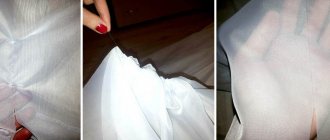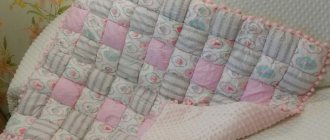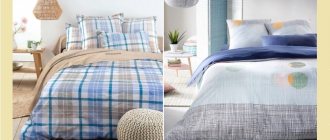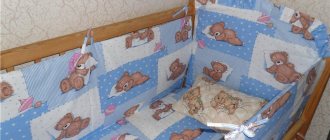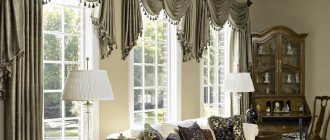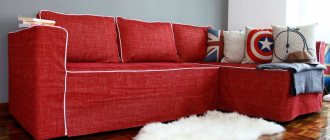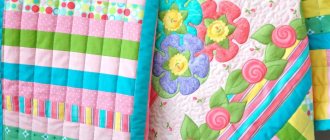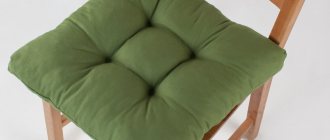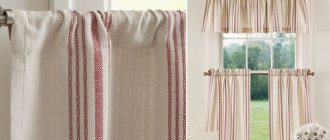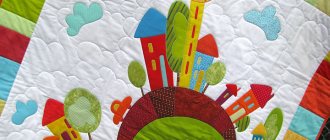If you like to sew and make things with your own hands, then the “Ask How” website offers detailed instructions on “ How to stitch a blanket or bedspread . Stitching products is a very painstaking job, but after reading our tips and mastering some of the “wisdom” of stitching, you will create a masterpiece that will delight not only you, but also your family and friends (if you give them a quilt, bedspread or pillowcase).
Let's say you have already decided on the size of the product, the texture of the front side of the blanket (bedspread), lining and gasket.
The lining is a fabric that covers the front surface from the back side.
Interlining - Places between the top and the lining. The thickness of the gasket depends on the purpose of the product. Thin fabrics (non-woven fabrics, wool) are used for stitching potholders and pillowcases.
But for bedspreads you need to take a larger material - padding polyester, batting or holofiber. The cotton wool layer is excluded, because Products filled with cotton cannot be washed.
To prevent the layers from bunching up, they are connected to each other with a stitch.
The stitch of a blanket (bedspread) can be different. If you are making a stitch for the first time, then make it classic - squares or random lines:
You can make a stitch on a baby blanket (bedspread) in the shape of a sun:
In the future, when you master the stitching technique, you can move on to more complex shapes - geometric shapes, ornaments or patterns:
Stitch pattern option: if the pattern is on the front surface with large flowers, you can stitch it by tracing them along the contour, which will become a wonderful pattern. Show your imagination and create.
Selecting a bedspread model
The simplest bedspread is a rectangle made of fabric , preferably tapestry. It can be cut out and sewn without lining.
If you want to have a silk or satin bedspread, more elegant, and also with a frill along the edge, you need to additionally stock up on padding polyester and fabric for the lining.
For the bottom layer, a simpler fabric is usually selected.
by-step instructions below are intended for those craftswomen who are starting to create a quilted bedspread on their own for the first time, bringing their own ideas into the work.
General rules for needlework
In order for a thing to create a pleasant impression, it must be made accurately in geometric terms and be neat. To do this, you need to follow some rules:
- To prevent an item processed using patchwork technology from shrinking after washing, the purchased fabric must be washed and ironed.
- If a previously used fabric is used for work, it must be treated with a solution of water and starch and ironed.
- To mark the fabric, use only soft crayons or, in extreme cases, a bar of soap. Ink pens and pencils will not work in this case.
- The fabric should be cut in the direction of the grain thread. This will help avoid unwanted deformations when stitching.
- To avoid deformation, strips and flaps of fabric must be smoothed across.
- All patches with images must be ironed in the same direction.
If you plan to manufacture a large item, you should first create a smaller sample of it in order to correct all the shortcomings in advance and finalize the design.
Preparing for work
Taking measurements
We arm ourselves with a measuring tape and measure the bed or sofa along, across and in height.
On a piece of checkered paper at a selected scale, we draw a drawing for clarity.
It turns out to be a rectangle, with strips attached to its sides, the width of which corresponds to the height of the bed or sofa.
Planning fabric consumption
You can immediately draw on the drawing the lines along which the bedspread will be stitched.
The drawing itself should consist of squares or diamonds of absolutely the same size.
It is easier to choose a convenient size on paper, where an unsatisfactory result can always be corrected.
Scheme on paper
When calculating fabric consumption, you need to multiply the total length of the frills by 1.5 .
Perhaps, for sewing them, the strips that remain after cutting the main fabric will be enough.
When choosing a fabric, you need to pay attention to its width.
It is better to immediately take a width of 280 cm.
Video: How to quilt a patchwork quilt? Secrets
- Now let's move on to the methods of stitching blankets. Square stitch for blankets, when the lines intersect at an angle of 90 degrees.
Square stitch blankets
- Diamond stitch for blankets, when the stitches create elongated diamonds. This is the classic and most common way to stitch blankets.
Diamond quilt stitch
- Also interesting and unfairly forgotten recently is the “wave” stitch method.
Wave quilt stitch
- And numerous methods of fancy stitching, the beauty of which directly depends on the experience of the craftswomen.
All kinds of stitches for children's and adult blankets
All types of stitches are performed according to the same pattern:
- Marking with chalk, washable felt-tip pen or pencil;
- Note;
- Stitching with dense stitching.
And finally, we attach a video of machine stitching a blanket.
We cut and sew
Layer cutting
Pattern for cutting the bedspread
If satin or silk is chosen, the materials are quite slippery, and the cutting process must be approached carefully.
It is most convenient to fold the fabric in half lengthwise so that the length of the upper part from the fold line is equal to half the required length.
You can do the same with width. Then, closer to the cutting line, connect the layers in several places with pins or needles.
In the same way, the padding polyester lining and the bottom layer are cut to size, but there is no need to allow for shrinkage.
Stitching the layers
This is necessary in order to fix the shape.
Marking the drawing
Only a top-class seamstress can afford to quilt a bedspread directly on a machine. The rest will have to be patient and have a template cut out of thick paper based on preliminary calculations.
Drawing stitches
The template (square or diamond) must be life-size.
Starting from one of the corners along the front side of the product, we apply our workpiece and, trying to capture all three layers, “draw” lines with a basting stitch.
Once we have outlined it, we move the square (rhombus) close to the line on one side, and the adjacent side to the edge, and sew again.
And so on until we reach the opposite corner.
Stitch
Sew on the frill
Frill
The main requirement: all typesetting strips must be cut in the same direction. Longitudinal or transverse - not so important.
Decorating the bedspread with a pleated or finely gathered frill is a matter of taste and habits of the craftswoman.
Step-by-step instruction
To make the quilt smooth and beautiful, each of the prepared parts must be ironed well. This way you can avoid unnecessary folds or lumps during production. After ironing, you need to cut off the protruding threads and then overlay all the parts except the filler. This can be done on an overlocking machine, but if you don’t have one, make a snake seam with a simple sewing machine.
When doing the work by hand, the edges are processed with a buttonhole stitch, placing the stitches at equal intervals. For this purpose, threads are selected according to the color of their base, as well as its type. If you do not treat it, the blanket will begin to creep around the edges when used, and filler will crawl through small holes.
The following steps follow:
Assembly
- the first piece of material is laid out on the floor so that its front side is at the bottom;
- a layer of filler is placed on top;
- on top is the second fabric piece, right side up.
The assembled workpiece is carefully straightened out and secured with sewing pins so that its parts do not move to the sides. Pins are inserted not only on the sides, but also in the center of the blanket in order to evenly quilt the fabric. Next they start drawing.
As a workout
It's difficult to get a perfect result the first time.
Those who don’t want to take risks can, before sewing a silk quilted bedspread, first practice on a patchwork quilt , for example, for a crib.
patchwork technique allows you to sew a hand on even long seams according to an almost finished pattern, or rather, prepared on the basis of an idea.
Patchwork technique
When making patchwork, any worn items available in the house are used , and scraps from old jeans will add strength to the bedspread if they are “fitted” into the overall scheme.
If the work went smoothly the first time, and the result inspired new products, then the craftswoman has succeeded!
Source
Patchwork techniques
Despite the obvious desire to create a complex masterpiece the first time, it is better for beginners to give preference to traditional basic techniques - such as quick squares , watercolors , magic triangles and stripe to stripe . They use the simplest geometric shapes and will not cause problems during operation.
Quick squares - the name speaks for itself, the work is assembled from square scraps of different colors. If the workpiece is rotated 45 degrees relative to the stitching, a diamond-shaped pattern will be obtained. There is a method in which squares are cut out from several pre-sewn ribbons - then triangles appear in the design.
Chess is a subtype of square technique in which elements of two colors are arranged in a checkerboard pattern.
How to sew a beautiful and cozy bedspread with your own hands
The interior of the bedroom should not only be conducive to sleep, but also pleasing to the eye during the daytime. How to achieve this? Take a thorough approach to the issue of bedroom decor. The choice of textiles plays a primary role here.
A snow-white bedspread will be the perfect addition to any interior!
The most important place in the bedroom is occupied by the bed, which means its decor will attract maximum attention. How to make a bed attractive? Place an interesting blanket on it.
A homemade bedspread will fill your bedroom with comfort and warmth.
In stores it is difficult to find a bedspread that you immediately like, that will naturally fit into the interior of the room, and that will perform the necessary functions. It is not always possible to order tailoring of textile components of the interior from an atelier. Therefore, an excellent solution to the problem would be to sew a bedspread with your own hands.
By machine or by hand
How to make quilted fabric if the volume of the product does not allow it to be pulled under the sewing machine? In this case, you can fix all three layers manually. It's much easier than creating a stitch pattern on a machine. The blanket in this case is sewn like this:
- All three components of the blanket (front part, filler, lining) are laid out on the table on top of each other.
- The attachment points are marked with chalk.
- A hole is pierced with an awl.
- A needle and thread are used to make several stitches through it; you can sew small buttons on the front side at the attachment point.
Deciding on the model, fabric, color
Sewing a bedspread is not difficult if you have basic cutting and sewing skills. After all, any simple-cut bedspread is a simple rectangle of fabric.
A baby blanket should be soft and pleasant in texture.
An ordinary piece of material of the required size must be processed in such a way as to obtain the desired result. The bedspread can be light, flowing, without lining, or thoroughly dense, with stitching. In addition, a banal rectangle can be decorated: add frills, ruffles, decorative stitching, embroidery, applique and get a unique bedspread.
The bedspread should be chosen based on personal preferences, the overall style of the room, and the purpose of this textile element.
Everyone chooses the style and design of the bedspread for themselves.
An excellent solution would be a double-sided bedspread. If the sides are made of a single fabric, then it is extremely easy to use. There will be no need to worry about which side to place it on the bed. When the turns are with different patterns, you will have the opportunity to change the look of the bedroom according to your mood, covering the bed in different ways.
Choose a fabric that will only give you a comfortable feeling during use.
A bedspread decorated with various decors (ribbons, lace, puffs, flounces) will give the room incredible comfort and create a romantic atmosphere. At the same time, the abundance of textile components in the lower part performs a practical function - it hides the bed frame.
A silk bedspread is stylish, fashionable and sophisticated!
A bedspread made of smooth satin, silk fabric or a tapestry version will add sophistication to the room. The use of shiny fabric and gilded trim will add chic and pomp.
A thick-pile bedspread made of wool or fur will do an excellent job of providing additional insulation and will add softness and comfort to the room.
A quilted bedspread will protect you from the cold, create a homely, well-groomed environment, and an atmosphere of warmth and comfort.
Complex bedspread patterns will require more effort and skill from the seamstress.
ADVICE. For a craftswoman with minimal experience, it is better to choose no-frills bedspread models, fabrics that do not require special care in the work. An excellent option would be cotton, medium-weight blended fabrics.
The better the quality of the fabric, the more pleasant it will be to use the bedspread later.
Making a blanket
Before you start work, you need to carefully select the materials. You can use different fabrics for the top and bottom parts. The main thing is that it combines with each other.
Features of a baby quilt. If you are making a blanket for newborns, there are some criteria to consider for this type of work:
- Temperature conditions for use. To make warm blankets for the winter, it is recommended to use wool or synthetic fibers. Cotton is suitable for a summer blanket.
- Hypoallergenic. One of the few advantages of synthetic fabric is low allergenicity. Also, according to experts, cotton and bamboo have hypoallergenic qualities, and many products are made from camel wool.
- Tactile qualities. If you are sewing a blanket from synthetic fabric, keep in mind the need to use a duvet cover. But synthetic filler is the best option. This padding makes the blanket almost weightless, and babies feel very comfortable with it.
- Ease of maintenance. The material you choose for the blanket should be hygroscopic and not lose its qualities with frequent washing.
Choosing a color
The color scheme of the product must match the style of the room, but can be seasonal, taking into account the lighting of the room and its size.
The type of fabric for the bedspread should also be selected based on seasonality.
Heavy bedspreads are best used in large bedrooms.
Getting ready to sew
When the choice of model, type of fabric, color has been made, you need to decide what you will need in the work and how to sew a bedspread with your own hands. The first thing you need to consider when sewing a bedspread is fabric consumption. To do this you need to make simple measurements.
The delicate colors of the bedspread always add lightness to the entire room!
Required Tools
Sewing a blanket begins with measuring the bed. The product should completely cover its entire area and hang slightly on three sides. To sew a blanket you will need:
- roulette;
- centimeter;
- awl;
- pins;
- spool of thread with needle for basting;
- chalk or a sharpened piece of dry soap;
- sewing machine.
Sewing tools
Calculating fabric consumption
To calculate the required amount of fabric, you need to know its width. If it is 1.4 m, then for a bedspread for a double bed you will have to cut out 2 parts of the main fabric and sew them together. This is not always acceptable for the aesthetics of the finished product. Therefore, it is advisable to take care of the required fabric width in advance.
A lot depends on the choice of the initial cut pattern; try to choose the ideal one for your bed.
It’s easy to calculate the fabric for the top of the bedspread: you need to know the length, width, and add a few extra centimeters to them. The fabric consumption for a bedspread with a frill should be taken into account with regard to folds, if they need to be laid. If they are present, the length of the strip must be additionally multiplied by 1.5.
An ideal and precisely thought out pattern for a bedspread - all you have to do is substitute your values.
With a fabric width of 2.8 m, most likely, 1 length of the product will be enough. In this case, the frills should fit into the remaining width of the fabric. If the fabric is 1.4 m, then it is necessary to lay 2 lengths of the main fabric and the total length of all sides with a frill. In this case, the fabric consumption is significant, and the quality of the bedspread will suffer due to additional seams.
For sewing bedspreads, choose the fabric that will be easier for you to work with during the sewing process.
Pattern
Having decided on the size of your quilt, you need to make a pattern from the purchased material. The first thing to consider is that there will be some shrinkage in the finished hand quilted product, as after the process the length will be reduced to 4 centimeters on each side. If you use binding for edging, there is no need to leave extra centimeters, but if such a technique is not in the plans, then about 5 centimeters on each side will be rolled up.
The insulation should be uniform, without lumps or tears.
So, if the standard size of a quilt is 220x200 centimeters, then for your pattern you will need to cut out 2 pieces 229x209. This is the case when using thin padding polyester, but if you put thick padding polyester or fluff inside, then the parts should be longer on each side by another 5 centimeters. The pattern of a quilt for a child will look different, since in this case you should start from the dimensions of the crib.
When the parts for the base are cut out, the filler is cut out. Let's consider the simplest option - padding polyester. Measure out the required length and width and cut with ordinary scissors. The insulation should be uniform, without lumps or tears.
We cut and sew
Having completed the preparation of the necessary materials, we proceed to the most important task - cutting out the bedspread for sewing. The selected material directly affects the complexity of subsequent actions. With light, slippery fabrics (silk, satin), extreme caution is needed when cutting and subsequent sewing of the product. Forming the stitch will present additional difficulties.
You can decorate your bedspread with a neat frill, which will always add elegance to the appearance of your bed.
ADVICE. The presence of a complex pattern on the fabric requires precise adjustment of the elements during the cutting and sewing process. Choosing a solid color material will make your work much easier.
Patchwork quilts are becoming more and more popular every year.
The best way to cut is to fold the fabric in half so that the length of the main fabric is half along the fold line. You can set the width in the same way. Then thoroughly level the fabric and pin it together. The cutting should be carried out exclusively on a flat surface, and do not allow cutting of materials in the air.
Even a quilted bedspread can look different depending on the pattern you choose.
The frill does not have to be one-piece. You can use the resulting leftover fabric. It is important that all typesetting strips are cut in the same direction (lengthwise or crosswise).
To create a patchwork bedspread, select pieces of fabric that match each other in color and texture.
If the bedspread requires the presence of lining fabric, a synthetic padding layer, they are cut out by analogy with the main parts. In the process of stitching, they are connected into a whole blanket. If there is a pattern on the fabric, it must also be taken into account when cutting.
Bright blankets for sleeping beds will always charge you with positive energy before bed.
Next it’s time to sew all the parts together. Using a sewing machine, we connect the base of the bedspread with the frill. To do this, place the parts with the wrong side up and place seams along the edges. Do not forget to add folds if they are provided for in the model. It is easy to sew a bedspread without unnecessary details. If there is a lining or insulation, all layers must be folded evenly together, then sewn.
A patchwork quilt is best created from not very bright pieces of fabric.
ADVICE. It is better to pre-clip additional parts with pins along with the main ones, or make hand basting seams.
If there is a stitch, you should first sew its seams, then sew the main elements. If you have no experience, it is better to sew the stitches by hand first.
For a children's bedspread, you need to choose not only a pleasant color, but also high-quality natural material.
Preparatory stage
The lower part of the bedspread is cut out when the upper part has already been assembled, although this is not an ironclad rule. The main thing is that the padding polyester and the bottom part are slightly larger than the top (let them protrude 5-7 cm on each side) - with the expectation of some movement and displacement during the stitching process. Next, you need to fold a quilt - a “layer cake” from the bottom panel (lay face down), padding polyester and top panel (face up). It will be more convenient to do this on the floor. It is better to sweep all three parts through. Pin section by section and sweep randomly. This way there will be less displacement.
How to quilt a hand-sewn bedspread on a regular household machine
Trial version
When you don’t have enough sewing experience, taking on a responsible job is always scary. Especially if the choice fell on complex fabrics or bedspread patterns. In this case, an excellent option would be to sew a trial version yourself.
Anyone can create a beautiful bedspread with their own hands, the main thing is to charge yourself with a lot of desire.
This is a great way to create a beautiful bedspread from simpler materials, practice making even seams, laying folds, stitching, and taking into account the pattern.
ADVICE. A good training option would be a patchwork-style bedspread. This technique requires painstaking work, but it provides invaluable experience.
A children's blanket complemented with accessories-toys in the same theme.
Finished products can be used in the country house or in a children’s room. The skills of creating a bedspread with your own hands will undoubtedly come in handy in the future. The question of how to sew a bedspread will no longer arise.
Sleeping beds can be complemented with bedspreads that match the aquatic color scheme with the bed linen.
Sewing a bedspread with your own hands is not such a difficult task. This will require a little time, effort, and skills. Accurate calculation and patience guarantee a beautiful and cozy bedspread.
High-quality edge sealing
Machine finishing the edge of a quilt
There are many ways to create a beautiful edging, the most common is “cheesecake”.
First of all, leave a few centimeters free at the back of the bedspread; if you skipped this step, use a separate wide fabric tape. The backdrop (or tape) needs to be folded over to the front side and a seam made around the perimeter of the product, trying to get closer to the edge of the folded area.
Finishing a blanket with bias tape
We pin the corner of the edging with pins
We attach the binding, checking how the needle catches the lower half of the binding on the wrong side
DIY bedspread
Sewing a bedspread with your own hands is not only a way to save on a factory product, but also an opportunity to bring a piece of your soul into the interior. A bedroom is a place where a person spends a significant part of his life, so it is important to make this space as comfortable as possible for relaxation. Any textile products create an extraordinary atmosphere of comfort in the room; making them yourself using detailed instructions is very simple. Today we will talk about how to create a bedspread.
DIY bedspread
Preparing the sewing machine
The machine also needs to be prepared in a special way - lower the conveyor teeth or install a darning plate. In the free stitch technique we do not need them, since we will be moving the fabric ourselves. For information on how to lower the teeth on your sewing machine, read the instructions that came with it. This is usually done using a lever provided for this purpose.
How to quilt a hand-sewn bedspread on a regular household machine
Next, you need to adjust the tension of the upper thread (it is better not to touch the lower thread). To achieve the perfect tension, take a quilt sample (a small sample square made from the same fabrics and filling as the main blanket) and stitch across it until you adjust the tension.
How to quilt a hand-sewn bedspread on a regular household machine
A regular foot won't work. To quilt a quilt you need a special quilting foot (or for quilting, embroidery, darning). They are different, but the principle of their operation is approximately the same.
How to quilt a hand-sewn bedspread on a regular household machine
How to choose fabric for a bedspread?
Of course, for most people, the main criterion for choosing a particular fabric is its combination with other interior items. At the same time, it is worth paying attention to the texture of the material and its quality. We will look at the most popular types of textiles used to create blankets.
Table No. 1. Fabrics for bedspreads
| View, illustration | Description |
| There are both artificial and natural fur fabrics - in both cases, such a product will be very warm. However, these types of bedspreads are not suitable for everyone. After all, they are quite difficult to wash, and sometimes you even have to use dry cleaning services. | |
| As in the previous case, woolen products will be very warm. In addition, they have good wear resistance and better absorb excess moisture. It is worth noting that such material has a different texture, it can be a little thicker or thinner, and the final appearance of the product depends on this. The finer the wool, the lighter and airier the blanket will be. | |
| This is also a fairly popular material, which is used in the manufacture of various bedding. This blanket will be comfortable to cover yourself with, silk is very pleasant to the skin. The main disadvantage is that silk will require special care - extremely delicate washing. | |
| A very soft material that can be used to make baby blankets. Fleece will not leave irritation on delicate skin, moderately warms, is durable and has an aesthetic appearance. | |
| Natural fabric, which is also often used to create children's products. Compared to the previous option, cotton fabric may seem less comfortable for the baby, since natural cotton is not soft enough and does not warm well. | |
| This is a material that has an unusual decorative appearance. Thanks to its unique texture and patterns, it looks expensive, and such a bedspread can become an unusual accent in any interior. | |
| This material is made by weaving bamboo fibers. It is environmentally safe. At the same time, bamboo products do not require special care; they are quite resistant to wear. | |
| This is a dense, noble material, on the surface of which there are sometimes ornaments. It is often used to create various decorative bedspreads for bedrooms furnished in a classic style. | |
| This is a durable material that is also suitable for creating a bedspread. The only downside is that it is difficult to smooth out without using a steamer. But for some interiors this is even a plus, since an unironed linen bedspread gives a special charm and a certain carelessness. | |
| This material is best suited for making a lightweight bedspread. Any images on its surface do not fade for a long time, just as the plain fabric itself does not lose color even with numerous washes. | |
| This fabric can be classified as velvet analogues. At the same time, velor is less demanding in care, it is easy to wash and then dry. |
Prices for bedspreads
What should a baby blanket be like?
Before choosing materials and sewing, let's figure out what a baby blanket should be like.
Necessary requirements:
- compliance of the product with the season and temperature in the room where the child sleeps: if you choose the wrong blanket, the child may overheat, which can lead to heat rash and poor health, or freeze,
- a suitable size for the child: a product that is too small will not be able to warm the child, it will be uncomfortable for him, since with almost any movement the blanket will slide off, and too large will interfere with the baby’s free movements,
- light weight: a product that is too heavy can make it difficult for the child to breathe and disturb his sleep,
- lack of decorative elements: the child may get entangled in them or damage the skin.
Based on the standard ratio of height and weight of children from birth to 17 years old, you can determine whether increases or decreases are needed when sewing.
I bought my son a couple of blankets measuring 80x80 centimeters for his birth, he slept under them until he was almost two years old, despite the fact that he is very tall for children of his age. Later we bought a blanket 110x150, I think it will last him until he is about four years old. Therefore, in my opinion, all these standard sizes are quite subjective.
Before using the blanket, make sure that there are no threads sticking out anywhere! The baby may cut himself on them.
If the blanket meets all the listed requirements, you can rest assured that your baby will be safe and sleep well.
Table: standard sizes of children's blankets
| Infants (0–1 year) | 80x80 100x135 150x110 |
| Children from 1 year to 12 years | 100x140 120x150 |
| Teenagers 13–17 years old (one and a half years old) | 145x210 160x220 |
Optimal bedspread size
In order to understand what size bedspread we need, we need to take measurements from the bed itself (length, width). It is worth noting that the product that hangs down from the mattress looks best, so you should add about 60 centimeters to the width of the bed, and 30 centimeters to the length.
An example of a voluminous satin bedspread
Inconvenient moment
The most inconvenient aspect of stitching on a household machine is, of course, the size of the bedspread. However, it’s not even that as such, but the limited space between the body of the machine and the foot with the needle. There's nothing to be done about it. Here everyone adapts as best they can. The most problematic thing in this matter is the middle of the product, but it is from there to the edges that you need to start stitching. It is most convenient to roll the free edge, perhaps even winding it around a long stick.
PS All photographs in the work are used exclusively to illustrate what is written and are publicly available on the Internet
If you liked the article, don’t be lazy, give it a thumbs up, subscribe to the channel and write a comment. See you again!
We sew a bedspread with our own hands
There are a wide variety of techniques for making a bedspread with your own hands. The most popular ones should be highlighted:
Patchwork style bedspread: step by step instructions
To make such a product we will need the following:
The following tools and materials will be useful during the work process:
Step 1. First, you need to prepare templates from cardboard. For the bedspread itself, you can use pieces of fabric of any shape, including squares, rectangles, and triangles. However, the simplest shape is a square. This type of blanket is most suitable for beginners.
This is what the square template diagram looks like. It can be displayed on cardboard in any size. Just keep in mind that 1 centimeter is always left as an allowance
Regardless of the choice of one shape or another, it is necessary to leave a few millimeters of allowance
Step 2. Next, you will need to take fabrics of various colors and cut out parts from them exactly according to the chosen template. At the same stage, you have to think about the appearance of the finished product. You can transfer the color scheme to your notebook so as not to get confused.
The pieces should be placed in the order in which they are planned to be sewn together.
Step 3. The next step is to prepare the parts that will be easy to connect together. To do this, it is better to wash all the pieces of the future bedspread with powder and conditioner, then iron them thoroughly. The simplest version of patchwork is considered to be the production of strips that will be easy to connect with each other. This process will only take a few hours, but as a result we will get a single color canvas.
It is necessary to sew the strips exactly according to the width of the finished blanket
Step 4. Now we need to carefully iron the seams on the wrong side of our workpiece. This should be done carefully so as not to wrinkle the bedspread.
Ironing the back side of the bedspread
Step 5. Next, according to the size of the resulting patchwork fabric, you need to cut out the reverse side for our bedspread. For this purpose, it is best to use cotton fabric.
We cut out another part of the bedspread, spreading the fabric on a flat surface
Step 6. Now you should lay the lining fabric on the floor, right side down. Then another piece of fabric (insulation) is placed on it. To keep it on the surface, you can fix it with tape. It is important that the insulation is 5 centimeters less at the edges than other parts.
You will need to put a patchwork fabric on top of this material, after which you should connect all these parts with pins
Step 7. Now you need to sew all these parts together.
A special embroidery foot is used during the work process.
If desired, you can make a decorative edging of the finished blanket using braid, ribbon and other details. Some craftswomen prefer to make a frill from the same material.
Sewing machine prices
Quilted bedspread: step-by-step instructions
This technique allows you to get a product no less beautiful than in the patchwork style. The difference is that solid pieces of fabric are used here, rather than scraps.
During the work we will need the following:
Step 1. To begin with, it is recommended to wash all fabric elements (except for insulation). If this is not possible, then you should at least treat the fabric with hot steam from an iron. This must be done so that the blanket does not “shrink” as a result of subsequent washing.
We wash all fabric cuts
Step 2. Now the fabric should be placed on a flat surface. If it is a floor, then it is recommended to wash it first. For the front part of the bedspread, double-sided cotton fabric with a pattern is usually used. It should be of optimal width to eliminate unnecessary seams. From this material you need to cut a square measuring 230x230 centimeters (the dimensions may be different, at your own discretion). Its edges should be finished with an overlocker.
How to choose the right overlocker
Step 3. You will also need to cut a square from the lining fabric. Its dimensions will be slightly larger - 240x240 centimeters. The edges are also processed with an overlocker, and the allowances should be smoothed with an iron.
Square of lining fabric
Step 4. Since the stitches will be square, we will need a square template. The size of the square will be 23x23 centimeters. Now we need to use a textile marker and a long ruler to draw out the facing material from the reverse side into squares. You should start from the edge, moving towards the central part. At this stage, you will need to perform all actions with the utmost care. After all the lines have been drawn, you can put this template aside.
Using a square template
Important point! To ensure that the fabric lies flat on the floor, it is recommended to secure it with adhesive tape.
Step 5. Now you need to lay out the lining fabric on the floor and place a thin padding polyester on top of it. These parts must be secured together with large stitches. Now the facing fabric is laid on this blank, lines up. At this stage, you need to make sure that all parts of the fabric are positioned evenly without distortion.
Lay out all the layers of fabric one by one
Step 6. Now you can connect all parts of the future bedspread with light threads and a needle. You should sew from the middle, first in one direction and then in the other.
Sew the parts together
Important point! When you baste, try to avoid knots so that the threads can be easily removed.
Step 7. Now we need to quilt the blanket using a sewing machine. You should also stitch from the middle to the edges. First you will need to make all the transverse stitches, and only then the longitudinal ones. In this way, you should quilt all the free areas of the bedspread.
Sewing the quilt pieces using a sewing machine
For greater convenience, you need to fold the edges of the bedspread towards the middle
In addition, you should place a chair next to the sewing machine to fold the finished product. The sides of the blanket should be trimmed using the same long ruler. Excess material can be cut off with scissors.
Important point! The product must be stitched exactly according to the markings. In this case, it is better to slightly tighten the fabric.
Step 8. Now all that remains is to attach the fabric edging to the bedspread and carefully smooth it with an iron.
Sew the edging to the product
How to make a frill for a bedspread?
Quite often, this type of blanket decoration is used if the product has uneven corners. To get started we will need:
Important point! To create a frill pattern, you do not need to use only a whole piece of fabric. You can even use small pieces of fabric that will have to be sewn together (you will have to think about how to hide such seams).
Step-by-step instruction
Step 1. First of all, we need to take a ready-made quilted bedspread and make a pattern according to its dimensions.
Take the finished bedspread
Step 2. The next step is to make a edging pattern. To do this, you need to pin the material for the frill around the 100 centimeter perimeter. Now this fabric needs to be detached and measured.
We attach the material with pins
Thanks to the work we have done, we know how much fabric is required for 100 centimeters of bedspread. Now all that remains is to multiply the resulting value by the remaining length.
Step 3. It is necessary to cut the material for the frill into several parts that can be easily sewn together. They can be processed using an overlocker.
Step 4: To finish, all you need to do is topstitch the folds of the frill and then sew this ribbon to the finished quilt.
Sew the frill to the blanket
Video - Bedspread with frill: making
Making a blanket from pompoms for a child: step-by-step instructions
To create such an unusual children's blanket, it is better to take multi-colored yarn (it is advisable to choose the softest, tactilely pleasant options).
In addition, during the work we will need the following:
Step 1. First of all, we need to prepare a wooden frame, and then wind rows of acrylic threads onto it one by one. First they are fixed transversely, and then vertically. The end is secured to the top screw and then lowered to the bottom where it wraps around two more screws. Thus, the thread runs along the entire longitudinal side. After which the thread is turned across and led to the very end.
Pull the threads on both sides
Step 2. Now you should fasten the threads of a different bright color, which will serve as the basis of our pompoms.
We fasten threads of a different color
Step 3. Now comes the most difficult part of the work - you need to fix all the intersections with nodes. This is done to ensure that our pompoms do not unravel. At this stage, you should be careful not to miss every detail. Next, to get pompoms, you will have to cut the threads one by one using scissors. An incision is made in the central part between the intersection of the threads.
You need to cut the threads to get fluffy pompoms
In this way you can create a bedspread of any size.
The main advantage of a pompom blanket is that it can be made very quickly. In this matter, the main thing is to maintain consistency.
Video - Sew a bedspread
Knot stitch
In addition to the types of stitches described above, there is a less common knot stitch. It is done in separate stitches. The ends of the threads on the front side are tied with a double knot and cut off, leaving a few centimeters. If you pull a double iris thread into the needle, the effect of sticking tails will intensify. In this option, you can use threads of contrasting, bright colors. For greater decorativeness, small beads can be attached to the ends of the threads. Small buttons can be used as an intermediate piece between the fabric and the knot. Mark the locations of the knots. Pull a long thread into the needle and baste the fabric. Insert the needle and withdraw it at the marked places, i.e. in the places of the suspected nodule. Pull the thread without tension to the next mark and stitch again, etc. Then cut the threads in between the stitches. Tie the ends and cut to the required length.
Tips to help beginning craftswomen
In order to avoid mistakes when making a bedspread, you should take into account the advice of experienced craftsmen:
It is recommended to start making bedspreads with quilted products of simple shapes. They are quite easy to sew, and at the same time they have an attractive appearance.
In the future you will be able to practice on more complex products.
Let's think about the composition
Most often, a traditional quilt consists of a number of blocks. In a child's room there will be fewer of them than in a blanket for a double bed.
Between the blocks, if appropriate and adding elegance to the project, dividing strips can be located.
Without dividing stripes
With dividing stripes
And to give the blanket completeness, a border frame is sewn along the edges of the patchwork part. Sometimes there is no need for a border and then it is enough to simply cover the sections with a narrow border.
A patchwork block is a set of geometric shapes organized into a pattern. Most often the blocks are square. This form is the most convenient to work with. But there are also hexagonal, rectangular, octagonal blocks. We will also consider a sector in a radial pattern to be a block.
A separate point is the blocks, which are not a mosaic pattern, but a simple geometric figure. They are called single-segment. Here we include blankets made of squares, hexagons, stripes, rhombuses, triangles, trapezoids.
Triangles only
Just diamonds
All hexagons
How to add variety to a sketch? You can line up the blocks not only horizontally, but also place them “at an angle” or position them offset. This technique greatly enlivens the composition.
Diagonal arrangement
Diagonal arrangement + dividing stripes
To prevent the blocks from merging into a monotonous fabric, they are separated by strips of fabric of a matching color. But you always need to weigh whether these separators are needed. There are some patterns that, “clinging” to each other, create interesting optical effects. In such cases, separating strips will be redundant.
You can make a layout out of blocks with a repeating pattern, but you can use several patterns, or you can repeat none. Quilts from completely different blocks are often sewn by beginning quilters to practice their skills, and such products are called samplers. By the way, the most famous historical quilt “Dear Jane” is also a sampler.
This is interesting: Pattern Patchwork quilt with interesting pinwheels
How to care for the finished product?
In order for the bedspread to serve you for many years, you will need to follow some rules for caring for it:
Capricious fabrics need careful care
Following these simple recommendations will help preserve the original appearance of the bedspread for many years. Otherwise, any beginner can handle making a simple bedspread with his own hands. You just need to follow the instructions and perform all actions carefully.
Source
Cutting fabric according to a template: some nuances
In the case of this example, the required canvas dimensions are 150x190 cm. The squares of the ornament themselves should be 15x15 cm. It turns out that, together with the necessary material for the seam, their sides will be 17x17 cm. It is this size that needs to be made of a template from thick cardboard. In addition to helping with cutting, it will also serve as a standard against which you can check the correct dimensions.
PHOTO: YouTube.com The template is made from thick cardboard
Sewing flaps: where to start, what to pay attention to
First you need to sew the vertical, shortest strips of the future fabric. The flaps are selected according to the diagram and laid with their front sides facing each other. Once the sides are aligned, they need to be pinned together to prevent them from moving apart during the stitching process.
The seam is made carefully so that the edge of the foot goes clearly along the cut of the fabric. This way the seam will be even, located at a distance of 1 cm from the edge.
PHOTO: YouTube.com The edge of the foot should be flush with the cut of the fabric
Preparing strips for stitching into fabric
When all the strips are ready, you need to properly press the seams between the flaps. This is done as follows. In one strip, the seams should be steamed in different directions. To make it clearer for readers how to do this, you can refer to the photo example below.
PHOTO: YouTube.com Seams should be steamed and smoothed in opposite directions
However, there is one caveat here too. After the seams of the first strip are steamed, the second, not yet ironed, is laid below. Its seams should go opposite to the first one. The fact is that if they match, after finishing work on the patchwork quilt, the internal seams will be clearly visible, and this is completely useless.
PHOTO: YouTube.com The seams of one strip should be smoothed in the opposite direction from the other
What else will you need for work?
You can’t do without traditional sewing attributes, so you need to prepare or purchase threads, of two types. The usual ones will be needed for basting, others - No. 45, 50. Their color depends only on the desires of the author, it can be combined with the future product, or be contrasting. You will also need:
- pins, needles;
- chalk;
- scissors;
- centimeter;
- scotch;
- iron;
- colored pencils (felt-tip pens);
- segment templates (two) - plastic or cut out of cardboard (thick paper);
- sewing machine.
Blanket made from denim scraps
If the owners have accumulated a fairly large number of trousers that are still strong, and cannot throw them away, then this option can be considered a win-win. The product can be not only a summer blanket, but also an unusual bedspread.
Since even worn denim remains quite strong, most often a blanket is sewn from large squares or rectangles. However, areas that are even slightly worn or yellowed are not suitable for sewing.
Materials, tools
In addition to the usual sewing kit, you need to prepare:
- several (preferably many) jeans;
- lining fabric;
- filler (wool, padding polyester);
- wire cutters;
- constant iron.
Jeans can be of different textures, colors and shades: the more differences, the more original the patchwork quilt will be. The lining fabric must be soft, pleasant and warm. Wool is an ideal material for filler/insulation, but its price is the reason for the low popularity of this natural material in this “role”.
Stages of working with jeans
The process is already more or less familiar, but there are some differences from making a classic model, so you should go through all the stages of “jeans” work. The main feature of such a blanket is the fringe on the front (denim) part. It is obtained thanks to a seam that “looks” outward.
- Old jeans are washed, ironed, ripped, then all accessories are removed from the clothing and again armed with an iron - all suitable parts of the trousers are steamed again. 352 squares with a side of 12 cm are cut out of denim material. Exactly the same number of elements are made from the lining fabric, then from the filling.
- Each finished piece of denim is applied inside out to squares of lining and synthetic padding material. The two resulting blanks are connected so that the denim side is on the outside, then a machine seam is laid. Its width is 1.5 cm.
- To the first pair of denim-lining-painting polyester squares, the remaining parts are attached in the same way (with the right side of the jeans facing outward), obtaining the first strip. Then they move on to making the remaining blanks. Then the long elements are connected into a canvas.
- The final operation is making fringe - creating multiple notches along all seams. This important work is performed with wire cutters, but carefully, since the seams between the patches cannot be damaged.
The almost finished product is edged with the selected colored fabric, or the same denim fringe is made around the edges. A simpler option is to make a classic patchwork quilt, but this model looks much more interesting.
Do-it-yourself patchwork quilt is a topic that simply requires that the novice craftswoman at least once see the whole process for herself. And with this, all kinds of lessons - video tutorials - provide invaluable assistance. For example, here you can watch one of our popular videos dedicated to a cute product made from scraps:
